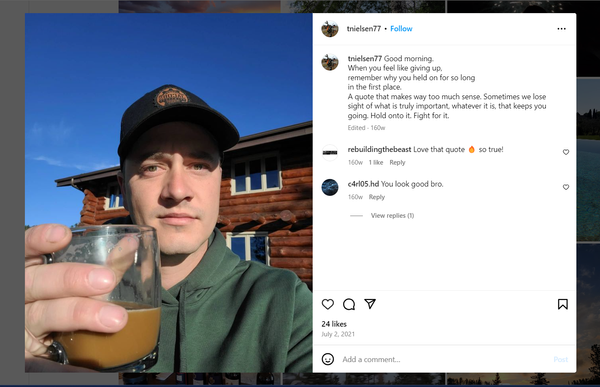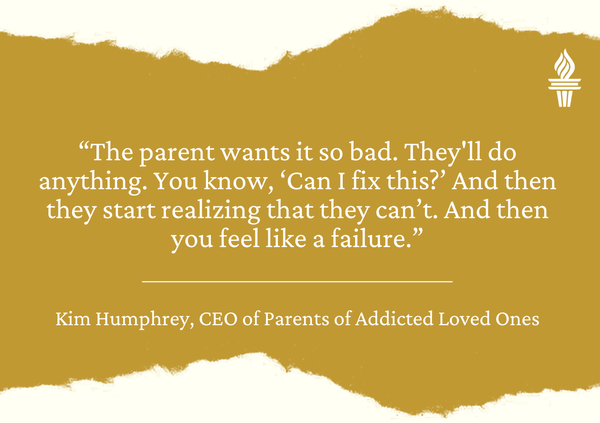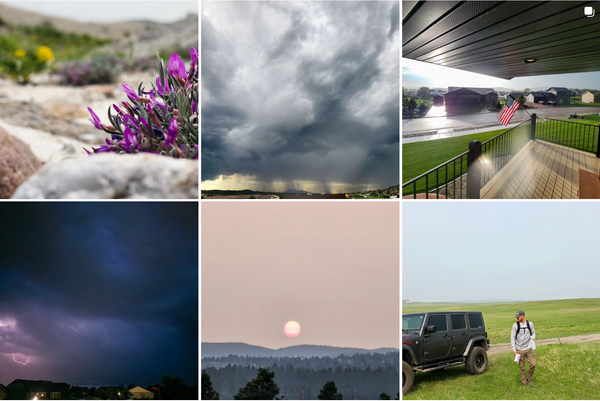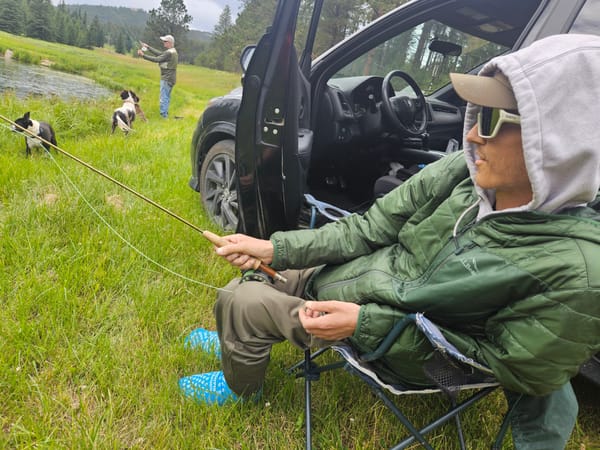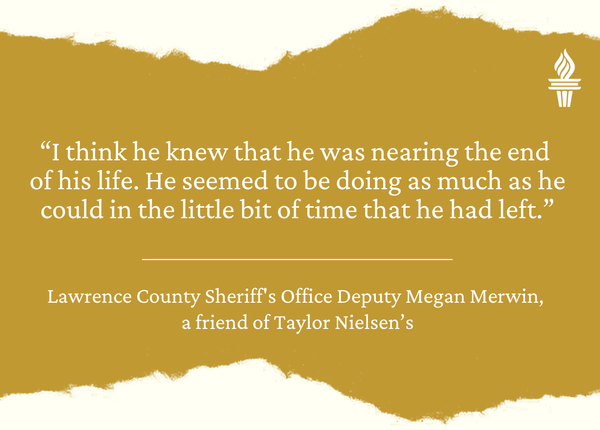South Dakota
Alcohol's impact: 35, dry and dying while waiting for transplant

OMAHA, Neb. – Taylor Nielsen rests in a room with a view. The wall-to-wall windows feature midtown on an overcast afternoon in late March. The natural light makes the hospital room more tolerable but exposes just how yellow Taylor’s skin is.
He drifts in and out of sleep. His dad, David Nielsen, hovers over his only child, places his right hand on Taylor’s swollen belly. He’s in excruciating pain. Fluid has bloated Taylor, pooling around his barely functioning liver.
David, 72, hopes his son’s suffering isn’t in vain. He encourages Taylor to share his experiences. “So we can help at least one to maybe thousands of people avoid going through this, right?”
Taylor nods.
Years of drinking have caught up with the 35-year-old. His liver has given out as have his kidneys. Taylor is dying.
All that can save him now is a liver transplant. He was flown from Monument Health Rapid City Hospital in South Dakota to Nebraska Medical Center in hopes of being approved.
A nurse walks into Taylor’s room asking about the barely touched breakfast tray.
“I got him to eat a couple of bites, that’s about it. He was having tummy aches, so it’s not a fun time to eat,” David adds.
Taylor has good days and bad. Sometimes he’s coherent, other times Taylor hallucinates. “Last week, he was talking up a storm,” David says.
Today is a quiet day, but Taylor mumbles that he’s not really hungry. He’s nervous to hear from the doctors.
Taylor’s gone through extensive testing, including blood work and a psychological evaluation. The transplant team will decide whether he’s a candidate for a new liver. Taylor and David expect to hear the answer today.
Observing David, you wouldn’t guess he’s waiting for life or death news. He’s calm, positive and tries to lift his son’s spirits. David, a lifelong veterinarian, knows enough about medical issues to ask questions. He’s Taylor’s biggest advocate.
“For what he’s going through, he’s doing really quite well,” David says. “When he’s on a roll, he’s on a good positive roll and he wants to help others, so it’s beautiful.”
Alcohol-disease deaths skew younger
I met Taylor once before. Two years ago, we had dinner at his dad’s, my neighbor in South Dakota’s Black Hills.
Taylor has aged decades since then: hair thinning, face gaunt, body skinny. A tube snakes into his nose for nutrition.
A once strong, howling wolf tattooed on his left forearm now looks malnourished on its shrinking, yellow canvas. Taylor, a former wildland firefighter, weighed 190 pounds. Now his 6-foot-2 frame is down to about 120.
He’s feeble, using a bedpan because he can’t walk to the bathroom. The hospital staff tries. He’s seen regularly by a physical therapist. The goal, someday, is to get Taylor to walk 100 feet. Today, they work on standing and taking a few side steps next to his bed. It’s a process, but with the therapist holding on, Taylor stands.
“Nice job, dude. Very good,” his therapist says. “Let’s take a couple steps to your left, OK?”
Taylor steps forward.
“I want you to step to your left side. Yep, ’cause we’re not moving forward, OK? Move that way,” the therapist instructs him.
“I’m trying to.” Taylor, confused and frustrated, says he has to go to the bathroom, ending what little progress he’s made.
Historically, most alcohol-associated liver disease deaths occurred in men in their 50s and older. But deaths are skewing younger.
For the first time, chronic liver disease is the leading cause of death of 30- to 39-year-old South Dakotans. Nearly all were caused by alcohol.
The beginning
Taylor wasn’t always a drinker. Growing up, he watched his mother struggle with alcohol and drugs, something he wanted to steer clear of.
But image is important to Taylor and he wanted to fit in. At summer house parties, he’d take a sip of beer, leave it and grab a second, wasting alcohol and annoying his best friend, Adam Bradsky.
“I remember talking to him like, ‘Taylor, it’s fine if you don’t drink. Just don’t waste the beer.’”
They met in high school in Rapid City when Taylor decided to live with his dad. He grew up with his mother in Ohio and visited David in the summer. When he was 15, Taylor decided to stay.
Taylor’s goofy with a great sense of humor. He’s a confidant, who listens to Adam without judgement. “I don’t think he ever betrayed my trust with any kind of secrets or anything that I ever told,” Adam says.
They both ended up going to the University of South Dakota. Adam left with a law degree. Taylor left a year before graduation. Follow-through is not Taylor’s strong suit.
It was after college when his friends and family grew concerned about his drinking. Adam vividly remembers the day he realized it was a problem. He stopped by Taylor’s place in rural Lead, South Dakota, on a random Wednesday. Taylor was on a tractor, haying, drunk. It was noon.
Taylor remembers his downward spiral starting in 2017 after his mother took her own life. “I had to pick up my mom’s ashes. And it really triggered me.”
He reached for vodka.
South Dakota saw record liquor store sales during the pandemic, with $126 million in 2021 sales when adjusted for inflation and seasons. The numbers don’t account for sales at grocery stores, bars or restaurants.
While they’ve declined the past few years, sales have yet to go down to pre-pandemic levels. Last year, liquor sales were still up 20% from a decade ago.
Drinking and mental health
Alcohol is by far the most commonly abused substance seen by Monument Health Rapid City Hospital. And it causes the most mortality and morbidity, says Stephen Tamang, M.D., a board-certified addiction medicine physician.
“Alcohol is particularly challenging because it’s prevalent. It’s relatively cheap, and it’s not in any way illegal. In fact, in some ways, it has a positive association,” he says.
Excessive drinking can permanently alter the brain. Alcohol becomes air, and an addict can’t get enough.
Sometimes a person gets sober after hitting rock bottom, the lowest point of their life. It’s unclear if Taylor has one. “We should’ve been there by now,” David says.
Taylor didn’t stop when his wife left, when he lost countless jobs or when his dad kicked him out of his home. He went to rehab and had short stays of sobriety. His longest: 260 days.
During that period, Taylor met Tory Long in 2021. “When I met him, he was vibrant. He was just beautiful, full of life. He was vigorous. He was sober,” she says.
His loved ones suspect Taylor also struggles with mental illness. Upwards of 80% of alcoholics have struggled with mental issues, whether that’s before or because of drinking. Taylor doesn’t remember ever being diagnosed.
“I have no (expletive) clue, but no one’s ever said anything of the countless doctors I’ve seen,” he says.

A family disease
At their lowest, David called the sheriff to remove Taylor from his home after he broke in and wouldn’t leave. David threatened him with a restraining order and the two became estranged until this year when David got the call Taylor was hospitalized.
Addiction is a family disease. Parents try to do all they can to save their child, sometimes to their own detriment.
Kim Humphrey of Phoenix, a former police officer, and his wife watched both of their children struggle with addiction. It put a strain on their marriage and health.
“We were to the point of becoming very reclusive and not going out and such depression that, you know, we just didn’t want to do anything,” he says.
Rural and reservation health providers face major hurdles in South Dakota
Patchwork system of health care in rural and reservation areas of South Dakota complicates care. This is the second of a two-part series on rural and reservation health care.
He and his wife started attending Parents of Addicted Loved Ones (PAL) support meetings. The nonprofit offers educational resources and support for parents dealing with a child’s addiction. Kim eventually became the CEO to help other parents.
“The parent wants it so bad. They’ll do anything. You know, ‘Can I fix this?’ And then they start realizing that they can’t. And then you feel like a failure,” he says
Kim learned firsthand you can’t control another person.
“The sad part of it is, what you can do is limited. And so what can you do? Well, I’m never going to stop loving my sons. And when they’re ready for help, I’m there for them,” he says.
David says he knew his son would get to this point. He just thought Taylor would be older. “Seriously, I did.”
On his kitchen island, you’ll usually find David’s Bible open with highlighted passages and notes in the margins. It’s how he copes, compartmentalizing and through his strong faith and “God’s healing miracles, strength and love.”
The news
It’s another March morning at Nebraska Medical Center. Taylor is quiet.
He and David expected the decision yesterday but haven’t heard from the doctors.
“There’s no communication,” David says, thinking it isn’t good news. He doesn’t let Taylor in on his suspicions.
Most patients who need a liver aren’t this young: Last year, the average age of a person listed for a potential transplant was 56.
Determining who receives a donated liver – or even gets on the waiting list – is a complex process. Many factors influence a candidate’s chances, including their blood type, underlying diagnosis and medical urgency. Over the years, roughly 2 out of 3 candidates ultimately received a liver.
A hospital staffer walks into Taylor’s room: “Hello. Hi. I’m with transport. We’re going to be taking you down to dialysis.”
Access to health care limited in SD rural and reservation areas
A weekslong investigation revealed numerous barriers to health care in rural and reservation areas of South Dakota that are leading to increased illness and higher mortality rates. This is the first of a two-part series.
Since his kidneys aren’t working properly, Taylor needs dialysis to rid his blood of waste and extra fluid that builds up.
He’s wheeled out of the room in his bed.
David waves goodbye. “Make your kidneys better, bud.”
Minutes later, David gets a phone call – the phone call. After niceties are exchanged, the doctor says Taylor doesn’t meet the criteria.
“I almost said, ‘Oh, they just gave him a death sentence,’ but I didn’t do that,” David says.
The stigma and shame
The Nebraska Medical Center declined to answer questions about Taylor’s case or liver transplants in general. It’s one of the biggest liver transplant centers in the region, recording just over 600 transplants in almost six years, behind Mayo Clinic in Minnesota.
People like Taylor represent a growing share of liver transplant candidates. Thirty years ago, about a quarter of the candidates were listed with an alcohol-related liver disease. Last year, they represented nearly half. The majority of these patients ended up with a liver.
There’s a stigma, of course, but Jenn Jones of Aurora, Colorado, who almost died from alcohol-associated liver disease, is working to minimize that. She points out that doctors also approve new livers for those who suffer from overeating.
“There’s not much difference between the two. It’s just a choice of what we decide to put in our bodies,” she says.
The shame patients go through is so overwhelming that Jenn founded Sober Livers, an organization to support those suffering from alcohol-associated liver disease, pre- and post-transplant patients.
She hopes the general public will provide empathy. “As long as the person is willing to get help, stop drinking … why would we not want that person a part of our society?”
There are no federally set guidelines for considering potential transplant candidates and it varies by transplant center. Some will not accept patients who are less than six months sober. A patient rejected by one hospital might be accepted by another. David’s not giving up and contacts a friend at another facility.
He decides not to tell his son the bad news yet. He doesn’t want Taylor to give up.
Father becomes caretaker
After multiple phone calls and networking, it’s clear to David that Taylor needs to get healthier and log more sober days before doctors will consider him for a transplant.
So far he’s been sober as long as he’s been hospitalized: three months and 17 days.
In early June, he’s well enough to come home and live in the Black Hills with David, who becomes his caretaker. “I don’t exactly enjoy cleaning up poop for an hour, but there’s no other option, so I just do it.” At 72, he didn’t think he’d be taking care of his 35-year-old son. “I thought maybe the other way around.”
David doesn’t think Taylor’s drinking, but he’s not completely following doctor’s orders either.
On a July afternoon, Taylor and David decide to go fishing. It’s been years since Taylor fly fished, something his dad does weekly.
Taylor drives his dad’s Honda SUV to the edge of the pond on David’s property. He still can’t walk unassisted.
On his passenger seat is his bill from Nebraska Medical Center. The total for his four-week stay: $219,980. Taylor only has to cover his Medicaid copay of $50.
He finds it funny. “It’s pretty cool because they were like money grabbers.”
Nebraska Medical Center discounted the bill by more than half, with South Dakota Medicaid paying $97,000.
Taylor’s tired today. Against his father’s advice, Taylor spends the night in his car in nearby Deadwood, South Dakota, after hanging out with friends. “I think he thinks I drank last night, but I did not.”
David’s ready to fish. Taylor needs to eat.
He grabs a take-out bag stacked on top of the car’s backseat and digs into leftover shrimp fettuccine Alfredo from the night before. “Oh God, this smells so good.”
It’s been sitting in his car since dinner and Alfredo isn’t on his low sodium doctor-prescribed diet, which he says he’s been following. “Except for this.” Pointing to the creamy pasta. “I don’t give a (expletive).”
Taylor won’t say the word but when asked if he’s an alcoholic, he nods yes. It’s something he has yet to acknowledge to his dad, even after all these years. Taylor has struggled throughout his life to take accountability.
David focuses on tying a fly to his line, hoping to catch three large brown trout that have been eating smaller fish.
Taylor leans his head back in the green camping chair and closes his eyes. “Honestly, this is so nice.” A clear fishing pond, with the Black Hills forest in the background is pretty serene.
Taylor loves the outdoors. He floods his Instagram with nature landscapes sprinkled in with a few foodie pics.
While Taylor relaxes, David continues to fish, casting back and forth, back and forth. “I think my goal for Taylor has changed,” he says, quietly enough for Taylor not to hear.
Earlier this year, David hoped Taylor would get healthy and back to being a functional adult. “That seems to be far off, right now. Like way far off.”
Taylor starts to fly fish, but he’s a few inches short of reaching the water, so all he catches are weeds. Taylor has a goal too: “Take care of him,” he says, pointing to David.
Dark clouds start rolling in accompanied by thunder.
“Let’s get out of here before we get fried,” David says
“I second that,” Taylor replies, a small sign that he still wants to live.
Wearing his hospital socks, he struggles to get out of the camping chair and into the car. His old sweatpants fall down, showing his diaper.
‘Getting sicker and dying younger:’ The cost of high health prices
The high cost of health care has caused nearly 1 in 10 South Dakota residents to skip necessary medical care, according to KFF.
“I lost quite a bit of dignity in the hospital.” Being poked, naked, using a bed pan, Taylor’s willing to share it all for one reason.
“If it could help save one person, that’s enough, right?”
‘I have not been drinking a drop’
Three days later, Taylor travels 45 minutes to Spearfish, South Dakota, to get dialysis but changes his mind. He decides to stay, and a friend gets him a motel room.
Over the next two weeks Taylor reaches out to a lot of contacts, asking for a ride or money, trying to negotiate them down. “Not even $50,” he texts. “$10” two hours later. He may sound like a desperate man trying to buy a drink, but when he talks on the phone, Taylor’s words don’t slur.
Friends and family also don’t believe he’s drinking.
While he speaks coherently, Taylor’s not always living in reality. He hangs around Walmart, saying he’s looking for a job. He admittedly misses some dialysis appointments but isn’t worried. Even though he can barely take two steps from his wheelchair, he buys hiking boots off of Facebook Marketplace.
Lawrence County Sheriff’s Deputy Megan Merwin met Taylor during one of his ambulance calls. He’s the youngest cirrhosis patient she’s met in her decade in law enforcement. Off-duty they became friends.
“I think he knew that he was nearing the end of his life,” she says. “He seemed to be doing as much as he could in the little bit of time that he had left.”
That includes fishing. Megan takes Taylor to Orman Dam near Belle Fourche, South Dakota, multiple times to catch catfish.
On Thursday evening, July 25, Taylor’s on a mission and mad. He wants a ride to Belle Fourche, 18 minutes north. “Spearfish sucks. I get the cops called on me every day for no reason.”
There’s usually a reason. Emergency services are called sometimes by strangers, many times by Taylor himself. One time he called for an ambulance because he needed help sitting up in the motel bed.
Taylor maintains he’s sober. “I have not been drinking a drop.”
His dad arranges for a hospice bed, if he’s willing to go. “I’m not in bad health. I just want to get out of here.” Denial is a strong demon.
Taylor never makes it to Belle Fourche.
The next morning, he’s found unresponsive and rushed to Monument Health Spearfish Hospital.
Taylor never wakes up.
“He’s finally at peace,” David says.
Places to go for help
If you or someone you love struggles with alcohol addiction, here are some places to go for help:
- SAMHSA’s National Helpline is a free, confidential, 24/7, 365-day-a-year treatment referral and information service (in English and Spanish) for individuals and families facing mental and/or substance use disorders. 1-800-662-HELP (4357)
• Alcoholics Anonymous (aa.org)
• Parents of Addicted Loved Ones (PAL) support group palgroup.org
Methods
Megan Luther is a freelance journalist for South Dakota News Watch, based in Mitchell, South Dakota. She has been in recovery for four years. Luther lives next to David Nielsen and started speaking with him and Taylor Nielsen earlier this year after he indicated he would share his story. She conducted additional interviews with medical personnel and other sources as well as Taylor’s friends to fact-check each interview. Freelance journalist Cody Winchester from Spearfish, South Dakota, analyzed data for this report. South Dakota News Watch CEO Carson Walker provided editorial and ethical guidance.
References
- Taylor Nielsen and his father, David Nielsen, were interviewed several times, together and separately, over the past five months, starting on March 27, 2024. Taylor’s last interview was the night before he died.
- Alcohol-associated liver disease death data, CDC Wonder.
- Leading cause of death in 30-39-year-olds, 2018-2022, South Dakota Department of Health Vital Statistics 2022. The oldest electronic data go back to 1960.
- Adam Bradsky, Taylor’s friend, interviewed July 15 and 31, 2024.
- Inflation and seasonally adjusted liquor store sales data provided by Dakota Institute, a nonprofit economic research organization.
- Stephen Tamang, board-certified addiction medicine physician at Monument Health Rapid City Hospital, interviewed June 3, 2024.
- Tory Long interviewed on July 20 and 31, 2024.
- Shivani R, Goldsmith RJ, Anthenelli RM. Alcoholism and Psychiatric Disorders: Diagnostic Challenges. Alcohol Res Health. 2002;26(2):90–8. PMCID: PMC6683829.
- Kim Humphrey, CEO of Parents of Addicted Loved Ones (PAL) interviewed on July 17 and 31, 2024.
- South Dakota News Watch analysis of United Network for Organ Sharing Data (UNOS) for the period January 1994-June 2024. Click here for more details on how we crunched the numbers.
- Health Resources & Services Administration, Organ Donation and Transplantation Data, Jan. 1, 2018-Sept. 30, 2023.
- Code of Federal Regulations for Transplant Program Process Requirements.
- Organ Procurement and Transplantation Network, General Considerations in Assessment for Transplant Candidacy.
- Jenn Jones, founder of Sober Livers, interviewed on July 16, 2024.
- Nebraska Medical Center invoice.
Editor’s note: Monument Health Rapid City Hospital’s public relations manager, Stephany Chalberg, also serves on the board of directors of South Dakota News Watch.
This story was produced by South Dakota News Watch, an independent, nonprofit news organization. Read more in-depth stories at sdnewswatch.org and sign up for an email every few days to get stories as soon as they’re published. Contact Megan Luther at megan.luther@sdnewswatch.org. Freelance journalist Cody Winchester contributed to this report.

South Dakota
Pictures of semi-truck, name of woman released in Minnehaha County fatal crash

SIOUX FALLS, S.D. (Dakota News Now) – The South Dakota Department of Public Safety has released the name of the woman who was killed in a fatal crash in Minnehaha County last week.
64-year-old Patricia Archambeau of Mitchell died on January 5 due to her injuries in a crash that took place in the early hours of Saturday, January 3.
Archambeau’s 2012 Chevrolet Traverse was traveling eastbound on I-90 near mile marker 379, about four miles west of Humboldt, when she attempted to pull off on the side of the road.
At the same time, the Traverse was struck by a semi-truck, also traveling eastbound, and pulling a trailer. The truck continued driving east after the crash and has yet to be located.
On Sunday, the South Dakota Highway Patrol released two images of the semi-truck suspected of hitting Archambeau’s Traverse. The two photos were taken on I-29 near 41st Street in Sioux Falls at 2:25 a.m., about 12 minutes after the crash west of Humboldt.
Highway Patrol is seeking more information about a red Freightliner Cascadia semi-truck, missing its passenger-side headlight. If anyone has information, they’re asked to contact Highway Patrol at 605-367-5700.
Copyright 2026 Dakota News Now. All rights reserved.
South Dakota
South Dakota knocks off Denver 82-72

VERMILLION, S.D. (AP) — Cameron Fens scored 23 points as South Dakota beat Denver 82-72 on Saturday.
Fens also contributed 12 rebounds and four blocks for the Coyotes (9-9, 1-2 Summit League). Isaac Bruns scored 20 points while going 8 of 12 and 3 of 4 from the free-throw line and added six rebounds. Jordan Crawford went 5 of 11 from the field (3 for 7 from 3-point range) to finish with 13 points.
Gabe Oldham led the Pioneers (8-11, 1-3) in scoring, finishing with 24 points, 13 rebounds and two steals. Denver also got 19 points from Zane Nelson. Carson Johnson also put up 11 points and six assists.
___
The Associated Press created this story using technology provided by Data Skrive and data from Sportradar.
South Dakota
SD Highway Patrol releases new details on hit and run, asks for public’s help

SIOUX FALLS, S.D. (Dakota News Now) – The South Dakota Highway Patrol is continuing to look for the suspect in a deadly hit-and-run near Humboldt, SD.
In a Facebook post, the SD Highway Patrol has released new details regarding the semi suspected of committing the hit and run.
According to police, the semi is a red Freightliner Cascadia semi, missing its passenger-side headlight.
The semi was traveling eastbound from the Humboldt area on I-90 in the early morning hours of Jan. 3, 2026.
Police are seeking information, video, or pictures from 2:13 a.m. – 3:00 a.m. along I-90 and I-29 from the public.
If you have any tips or footage, contact the South Dakota Highway Patrol District 2 Office at (605) 367-5700.
Copyright 2026 Dakota News Now. All rights reserved.
-

 Detroit, MI1 week ago
Detroit, MI1 week ago2 hospitalized after shooting on Lodge Freeway in Detroit
-

 Technology5 days ago
Technology5 days agoPower bank feature creep is out of control
-

 Dallas, TX2 days ago
Dallas, TX2 days agoAnti-ICE protest outside Dallas City Hall follows deadly shooting in Minneapolis
-

 Dallas, TX6 days ago
Dallas, TX6 days agoDefensive coordinator candidates who could improve Cowboys’ brutal secondary in 2026
-

 Delaware2 days ago
Delaware2 days agoMERR responds to dead humpback whale washed up near Bethany Beach
-

 Iowa5 days ago
Iowa5 days agoPat McAfee praises Audi Crooks, plays hype song for Iowa State star
-

 Health7 days ago
Health7 days agoViral New Year reset routine is helping people adopt healthier habits
-

 Nebraska4 days ago
Nebraska4 days agoOregon State LB transfer Dexter Foster commits to Nebraska
